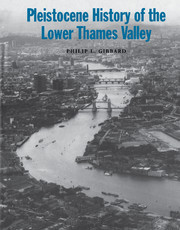Book contents
- Frontmatter
- Contents
- Preface
- 1 Introduction
- 2 Lithostratigraphy
- 3 Comparison of the pebble lithological composition of the gravel members
- 4 Sedimentary structures and depositional environments
- 5 Vertebrate faunal assemblages
- 6 Palaeobotany and biostratigraphy
- 7 Palaeolithic artefact assemblages
- 8 Palaeogeographical evolution of the Lower Thames Valley
- 9 Correlation with neighbouring areas
- References
- Appendix 1 Pebble counts from high-level gravels in the Epping Forest area
- Appendix 2 Pebble counts from the Lower Thames region
- Index
9 - Correlation with neighbouring areas
Published online by Cambridge University Press: 04 August 2010
- Frontmatter
- Contents
- Preface
- 1 Introduction
- 2 Lithostratigraphy
- 3 Comparison of the pebble lithological composition of the gravel members
- 4 Sedimentary structures and depositional environments
- 5 Vertebrate faunal assemblages
- 6 Palaeobotany and biostratigraphy
- 7 Palaeolithic artefact assemblages
- 8 Palaeogeographical evolution of the Lower Thames Valley
- 9 Correlation with neighbouring areas
- References
- Appendix 1 Pebble counts from high-level gravels in the Epping Forest area
- Appendix 2 Pebble counts from the Lower Thames region
- Index
Summary
The continuity of the fluvial aggradations recognised throughout the Lower Thames Valley and in some tributary valleys means that equivalent deposits must exist in neighbouring upstream and downstream areas. Upstream correlations have already been extensively discussed in earlier chapters, but here a summary of stratigraphical correlates in adjacent areas will be presented (Table 9). The correlations are made on the assumption that differential crustal warping has not been demonstrated between the areas.
Central Essex
The Kesgrave Formation (‘Group’) deposits are aligned approximately northeast to east across central Essex. They represent buried ancestoral Thames sediments that were laid down before the rivers' diversion (Rose & Allen, 1970; Rose et al., 1976; Bridgland, 1988a; Whiteman & Rose, 1992; Whiteman, 1992). Recent re-evaluation, by the last named author, has shown that the Formation can be subdivided altitudinally into a series of member-status units comparable to those described here. The deposits identified as deposits of north-eastward flowing tributaries, the Epping Forest Formation and the Warley Gravel, should conceivably have mainstream equivalents but it is not yet possible to correlate them with specific units within the Kesgrave Formation. However, the altitude of the tributary spreads suggests that they are of considerable antiquity (cf. Gibbard, 1979; section 9.3).
- Type
- Chapter
- Information
- Pleistocene History of the Lower Thames Valley , pp. 195 - 200Publisher: Cambridge University PressPrint publication year: 1994



